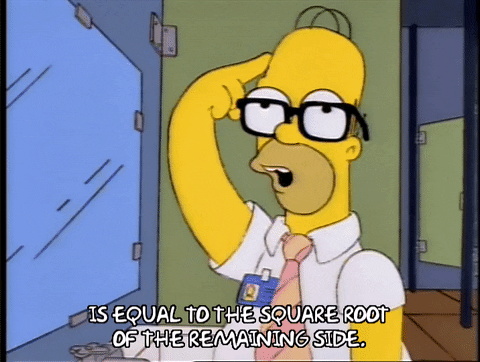Part 1 due Wednesday, September 28
Parts 2 & 3 due Monday, October 3

Introduction
The Pythagorean theorem—the square of the hypotenuse of a right triangle is equal to the sum of the squares of the two other sides—is arguably the most famous mathematical result. While many people remember the statement of the theorem from high school, way fewer people know a proof…and even fewer know that there are literally hundreds of proofs!
Summary
For this project, you and your team will:
- choose one of the proofs of the Pythagorean theorem to learn,
- create a dynamic worksheet in Geogebra explaining the proof,
- create a video lesson explaining the proof in your Geogebra worksheet.
Teams
- Work in pairs. You may choose your partner; let me know who your partner is.
Part 1: write a draft
As a team, choose one of the proofs (except Proof #7) listed here. Each team must choose a different proof. Reserve your team’s proof by commenting with its number on this post. After you choose your proof, you may use other resources to learn it if you like.
As a team, learn the proof and provide a hand-written draft of it that you are all happy with. One team member will submit an OpenLab post:
- Title your post [Partners’ names] Pythagorean theorem draft
- Select the category Pythagorean theorem draft.
- Upload a photo of the hand-written or typed proof.
- Include extra commentary about your team’s work if you like.
Part 2: create a Geogebra worksheet
Before your team creates a dynamic Geogebra worksheet demonstrating your proof, discuss how you would like your worksheet to work in your video lesson. Will it be a slideshow that you advance through? Will it have any animated features? Will you toggle the visibility of certain objects on and off during the presentation? Will you include text in the worksheet or instructions for student users?
Your Geogebra worksheet must:
- include a representation of all of the geometric ingredients of the proof,
- be self contained,
- pass the drag test (if a user drags some points around the important relationships among geometric objects remain; see Venema page 17).
Try creating your own Geogebra worksheet before collaborating with your team. Then you can work together by sharing .ggb files or using the browser app (there might be better ways to collaborate too!).
Part 3: record a video lesson
Together with your team, record a short video lesson (around 5 to 10 minutes) walking students through the proof in your Geogebra worksheet. Decide how you will divide the work of presenting together. Each team member must participate in the presentation*.
One suggestion:
- set up a Zoom meeting with your team; enable recording (you do not need to turn your video camera on),
- one team member can share the Geogebra worksheet on their screen,
- team members can hold a prepared back-and-forth conversation to explain the proof to students.
Submitting your work
One team member will submit an OpenLab post for the team:
- Title your post [Partners’ names] Pythagorean theorem Geogebra and video
- Select the category Pythagorean theorem final.
- Include team members’ names.
- Include a link to your Geogebra worksheet (for example, this can be a link to the online worksheet in your Geogebra account or it can be a link to a Dropbox folder containing the .ggb file).
- Include a link to your video (for example, a link to the video file in a Dropbox folder; or if you upload your video to YouTube, you can embed your video right into your OpenLab post by copy-pasting the link).
- Include extra commentary about your team’s work if you like.
Requirements
For full credit, your proof must be complete and correct, your Geogebra worksheet must satisfy the conditions above, and your explanation in your video must be clear.
What’s the point of multiple proofs?
While the Pythagorean theorem might be one of the most proved theorems, it’s not the only theorem with many proofs! Mathematicians often like when there are multiple proofs of a result—especially if they are very different—because they can help give different perspectives and deeper understanding of the result, its ingredients, and its implications.
I went to a great Zoom talk a while ago by Benjamin Dickman, who’s a math teacher in Manhattan, about another result with multiple proofs. It was really fun and inspiring! If you have time, you might like to watch the recording here.
History of the Pythagorean theorem
There are many accounts of the history of this famous theorem. Here is a paper that claims there is evidence that a proof was known 1000 years before Pythagorus’s time and connects it to the proof of another famous theorem—Fermat’s last theorem.
Geogebra samples
- Inspiration
- Example (Proof #7)




Charlotte and Angie
Proof #3
Irina and Rachel
Proof #4